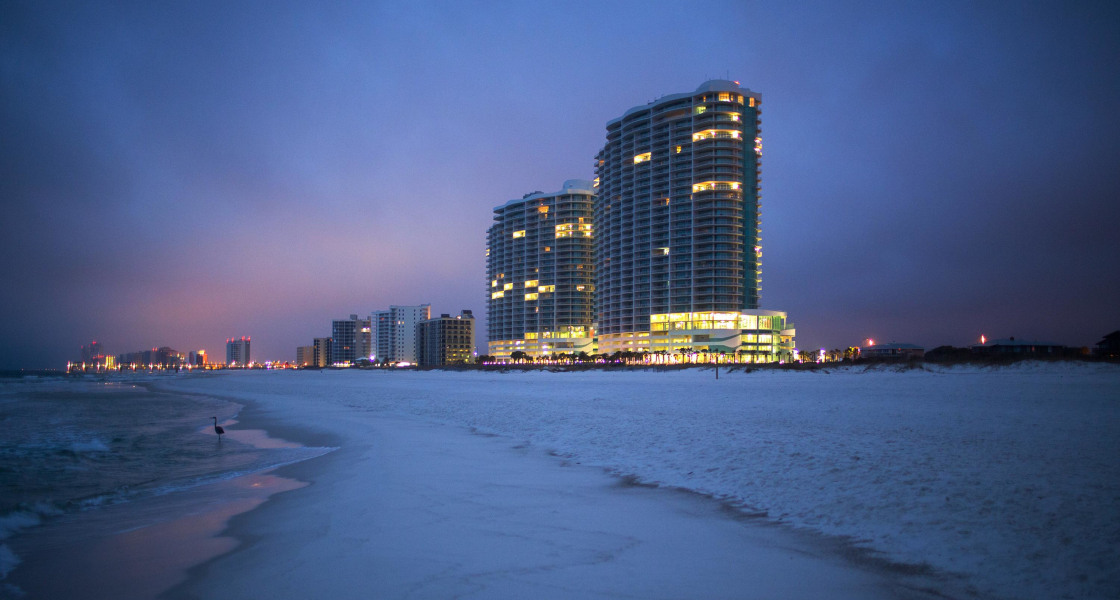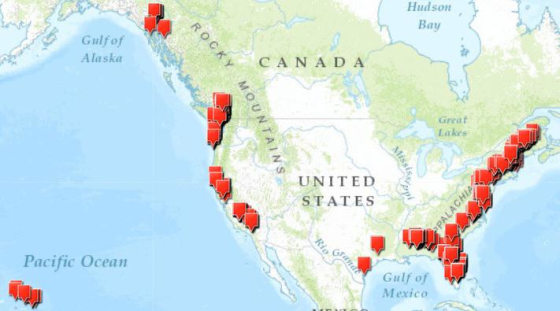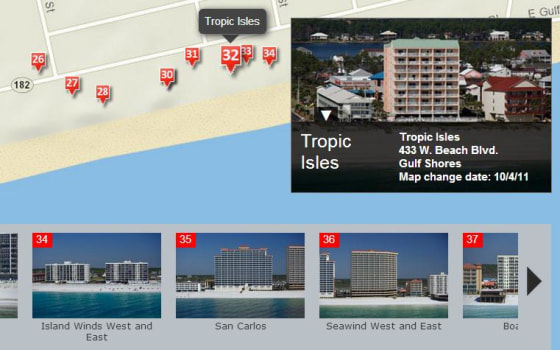Investigations

John Brecher / NBC News
Why Taxpayers Will Bail Out the Rich When the Next Storm Hits
GULF
SHORES, Ala. — As homeowners around the nation protest skyrocketing
premiums for federal flood insurance, the Federal Emergency Management
Agency has quietly moved the lines on its flood maps to benefit hundreds
of oceanfront condo buildings and million-dollar homes, according to an
analysis of federal records by NBC News.
The
changes shift the financial burden for the next destructive hurricane,
tsunami or tropical storm onto the neighbors of these wealthy
beach-dwellers — and ultimately onto all American taxpayers.
In more than 500 instances
from the Gulf of Alaska to Bar Harbor, Maine, FEMA has remapped
waterfront properties from the highest-risk flood zone, saving the
owners as much as 97 percent on the premiums they pay into the
financially strained National Flood Insurance Program.
NBC
News also found that FEMA has redrawn maps even for properties that
have repeatedly filed claims for flood losses from previous storms. At
least some of the properties are on the secret "repetitive loss list"
that FEMA sends to communities to alert them to problem properties. FEMA
says that it does not factor in previous losses into its decisions on
applications to redraw the flood zones.
And
FEMA has given property owners a break even when the changes are
opposed by the town hall official in charge of flood control. Although
FEMA asks the local official to sign off on the map changes, it told NBC
that its policy is to consider the applications even if the local
expert opposes the change.
"If
it's been flooded, it's susceptible to being flooded again. We all know
that," said Larry A. Larson, director emeritus of the 15,000-member
national Association of State Floodplain Managers. "FEMA is ignoring
data that's readily available. That's not smart. And it puts taxpayer
money at risk."
 NBC News
NBC News
The Gulf Coast experience
The
neighboring resorts of Gulf Shores and Orange Beach on the South
Alabama coast include a stretch of beach that was flooded by Hurricanes
Erin and Opal in 1995, Danny in 1997, Georges in 1998, Ivan in 2004, and
Katrina in 2005. The map changes here offer a vivid example of the
risks that come with such reclassifications.
The
direct hit by Ivan was the worst, bringing not gently rising
floodwaters but a 14-foot wall of water that leveled buildings and
flooded more than a mile inland. That’s why flood maps show most of this
beach as a "coastal velocity wave zone," the area with the highest risk
of damage from storm surge.
But
nearly all of the condominium towers are no longer in that high-risk
zone, including a 17-story condominium built where the old Holiday Inn
was wiped away by Ivan’s winds and waves, and another where the
McDonald's was a total loss. From 2011 through 2013, FEMA granted
applications remapping 66 out of 72 waterfront condo towers in Gulf
Shores to lower-risk flood zones or off the flood maps entirely. Four
others have applications pending. Just two applications have been
denied. And next door in Orange Beach, the map lines have been redrawn
around four high-rise condo buildings.
On
a single day, Oct. 25, 2012 — a day when FEMA was closely monitoring
Hurricane Sandy as it barreled toward the Atlantic Coast — a FEMA
manager issued a document
reclassifying a full mile of the coastal property in Gulf Shores. That
document, just one of the 533 cases found nationwide by NBC News, redrew
the lines to exclude 25 condo buildings from the highest-risk flood
zone.
This beachfront condo, the Island Tower, collected $11,562 for its damage from Katrina, and more than $250,000 from Ivan.
 John Brecher / NBC News
John Brecher / NBC News
The
Island Tower's condo association was paying $143,190 a year into the
National Flood Insurance Program. Now that it's been reclassified into a
lower-risk flood zone, its premium is $8,457 a year, a saving of 94
percent, according to records examined by NBC News.
Just
down the beach is the Royal Palms. It collected $58,230 for damages
during Katrina, and $889,730 from Ivan. The Royal Palms was paying
$218,484 a year, but after being changed to a lower-risk flood zone, now
pays only $6,845, saving 97 percent.
The
map changes in just these two towns resulted in at least $5 million a
year in lost revenue to the flood insurance program, according to
records examined by NBC News. All of these changes were approved by FEMA
despite opposition from the city officials in charge of floodplain
management.
 NBC News
NBC News
See a map from NBC News with details of the condominium projects in Gulf Shores and Ocean Beach. Some of the condo projects have multiple buildings, making more than 60 buildings in all.
Elsewhere
in Gulf Shores, homeowners are paying as much as $12,000 a year in
flood insurance premiums for their single-family homes, according to
insurance records. These homeowners are paying as much as several large
condo buildings combined.
Properties from Alaska to Maine
Because
waterfront properties are expensive, and it costs thousands of dollars
to hire an engineer to press a case with FEMA, the remapped properties
tend to be luxurious, either the first or second homes of
industrialists, real estate developers and orthopedic surgeons.
The 533 properties include a $4 million home in the Hamptons resort on Long Island, N.Y., owned by a married couple who direct Wall Street investment firms.
In Miami, the beneficiaries include the twin 37-story condos at ritzy Turnberry Isle in Sunny Isles Beach, and also the Regalia, "the most luxurious building in South Florida."
 Courtesy of Pictometry International Corp.
Courtesy of Pictometry International Corp.
In Naples, Fla., a $19 million home
was remapped last year out of the high-risk zone. The owner, Robert A.
Watson, former president and CEO of units of Westinghouse Electric and
Transamerica, said his property is protected by a floodwall, and he
sought the map change last year not to save money but because FEMA has
changed the map elevations in that area so many times. He said he wanted
to know for sure that a guesthouse would be permitted. (He called
mandatory flood insurance "a massive scam on the American people.")
In New York, FEMA granted the Mamaroneck Beach & Yacht Club's request
to be remapped from the high-risk flood zone in August 2012 — just two
months before the club was damaged and its outbuildings destroyed by
Hurricane Sandy, which stacked up yachts at its docks like pick-up
sticks. The club told NBC that its engineering study showed that FEMA's map was wrong.
"Sandy
was a once in a millennium event, and therefore cannot be the sole
determination for planning," said Eric L. Gordon, attorney for the yacht
club.





No comments:
Post a Comment
Hello and thank you for visiting my blog. Please share your thoughts and leave a comment :)